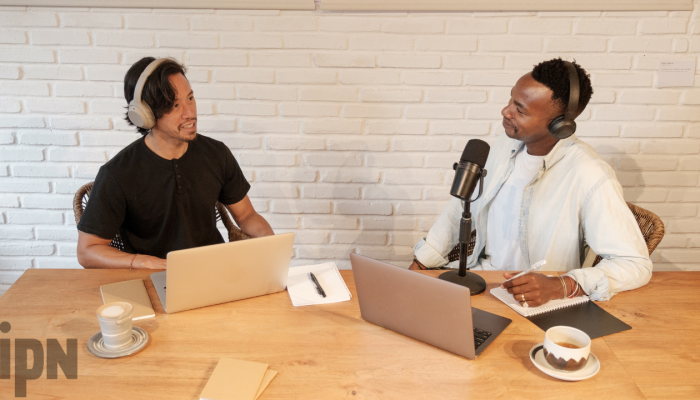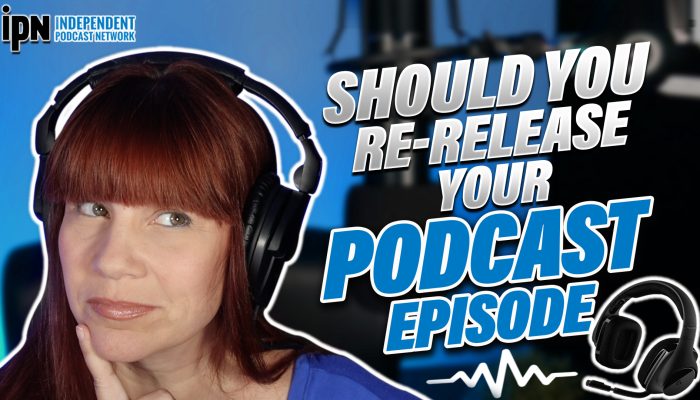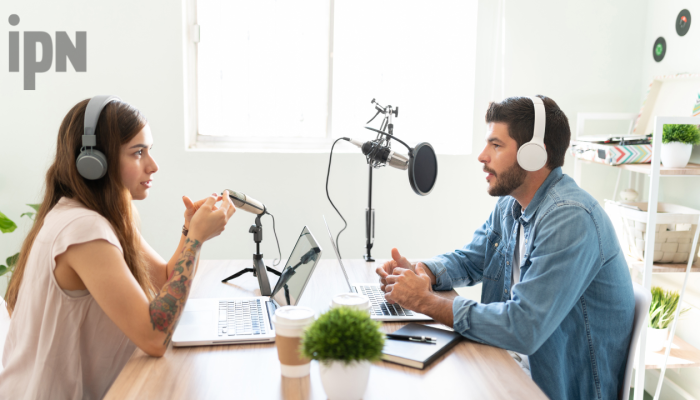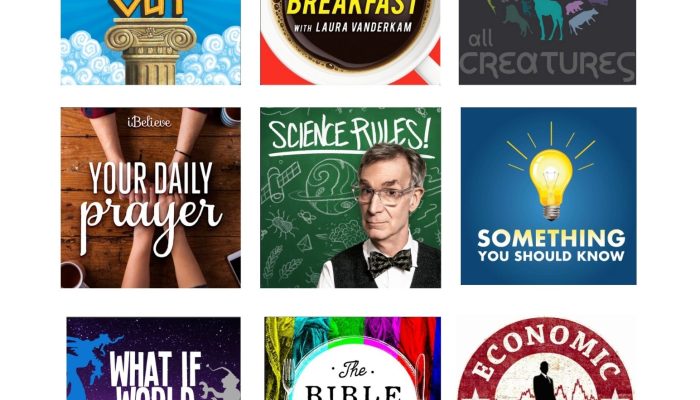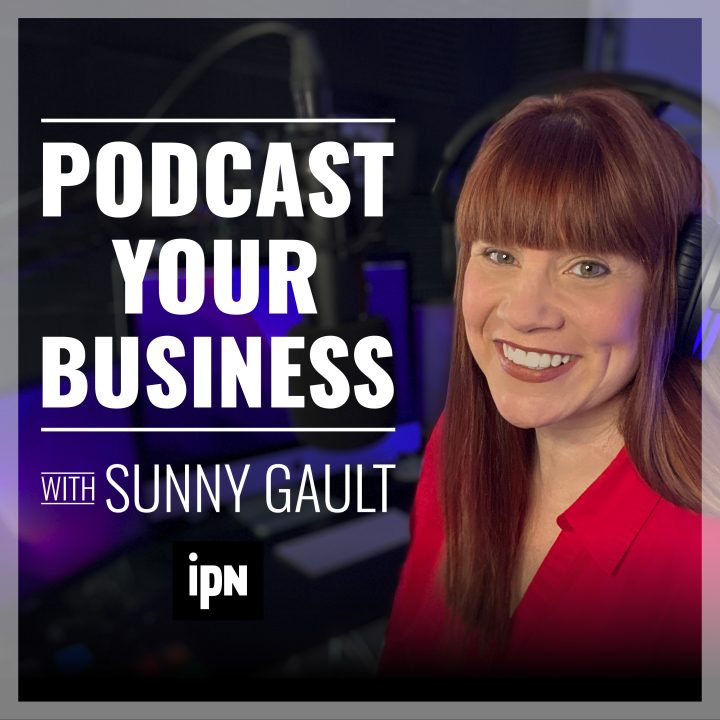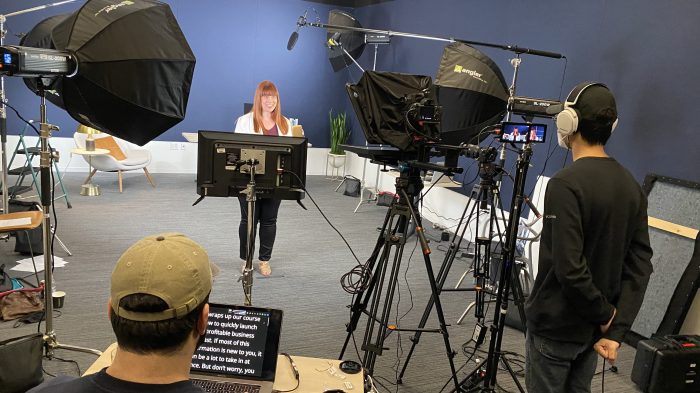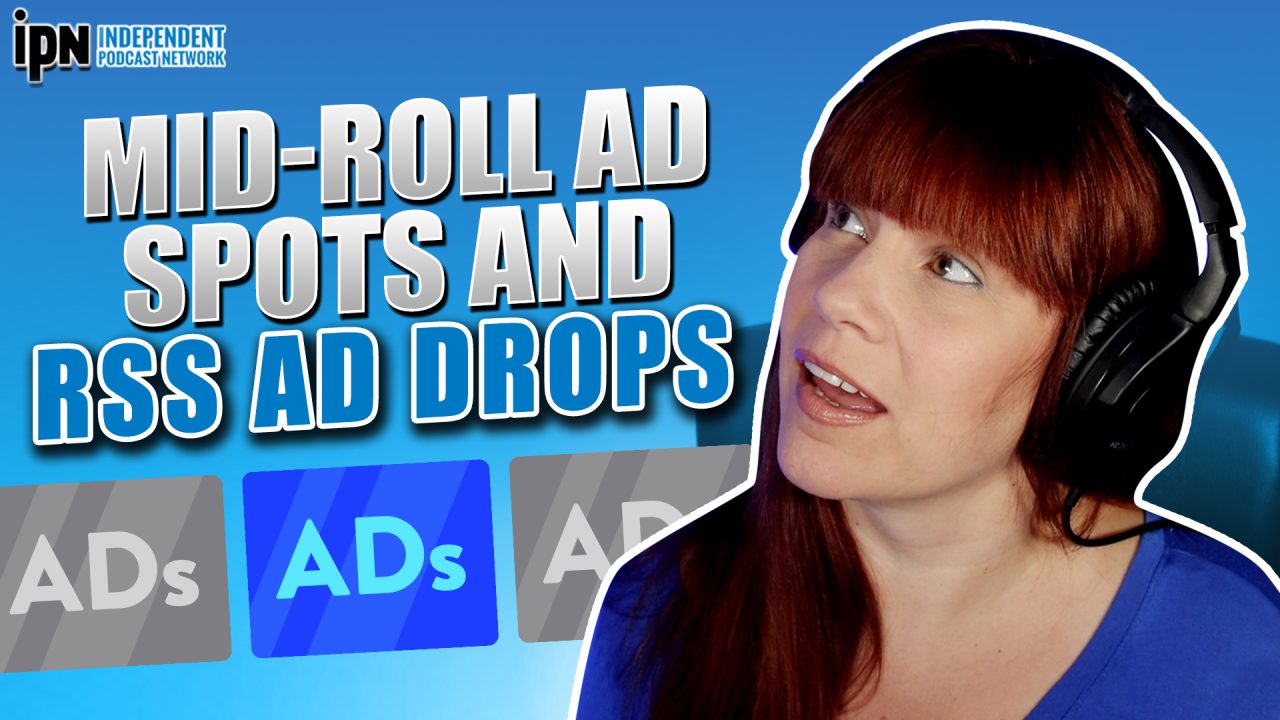
where you put your ads is key to conversion
Establishing a format for your podcast is essential if you’re planning to work with advertisers, or you want to promote your own products and services. Where you put these ads is just as important as what you say in these ads. And the most popular places to insert ads and promos are either in the mid-roll spot or as an RSS ad drop. Today you’ll learn more about how you can effectively use these locations to help spread your message to the world.
Here’s what we’re talking about today…
- What are mid-rolls and RSS ad drops?
- How can you effectively use these locations to spread your message?
- What are some common pitfalls to avoid?
get my guide for creating podcast ads
Want to know more about the four steps I use when creating ads for my own podcast? This is a great guide to print out and follow each time you’re writing new ads for your show!

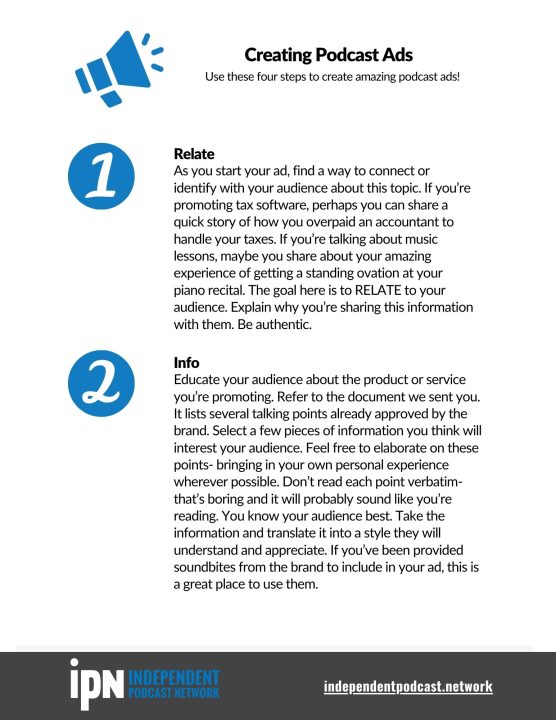
Episode Transcript
0:02
Establishing a format for your podcast is essential if you’re planning to work with advertisers, or you want to promote your own products and services, where you put these ads is just as important as what you say in these ads. And the most popular places to insert ads and promos is either in the mid roll spot, or through an RSS ad drop. Today, you’ll learn more about how you can effectively use these locations to help you spread your message to the world. Take it away, Mr. radio man. Podcast Your Business.
0:44
Hello, and welcome to another episode of Podcast Your Business. I’m Sunny Gault, and I’m a podcast coach and mentor who’s been podcasting for a really long time. I’m creeping up on two decades, guys, and most people didn’t even know podcasts were around back then. I am the founder and CEO of a company called Independent Podcast Network. I encourage you guys to visit our website at http://independentpodcast.network, because we’re always releasing free content to help you podcast bigger and better. But today, I am here to help you create amazing podcasts specifically for those of you who are doing this for your business. And we do this by mastering the five P’s of podcasting. Thank you, Mr. Radio, man. So what are the five P’s of podcasting? This is a concept and idea that I created when I started launching podcasts courses, which are all available for free for you guys. But I break things down into five key. So if you want to have a successful podcast, what do you really need to do? And I believe you need to go through the steps. The five P’s are prep, plan, produce, promote, and profit. So Prep has to do with asking yourself, should you even start a podcast? What is your intention behind this? What are you trying to accomplish? And then the planning is the look and feel the format for your show how often you’re going to release episodes, things like that. producing it, whether it’s audio or video is all about creating the content and the best way and most effective way to do that without you pulling your hair out. Promoting is telling everyone about it. So people actually no you have a podcast, Subscribe and follow you. And then profit is making money with this. Whether you’re working with advertisers or you for your business, you’re able to bring in more clients. Somehow this should benefit your business if your podcast is tied to it. Right. So Mr. radio man, what are we talking about today? Profit.
2:47
That’s right, anytime you’re talking about ads, or even promos, somehow you’re expecting to profit from this. Now usually, when we’re talking about ad spots, we’re talking about profit, because we’re being paid to include these spots in our shows. But that’s not always the case. You could be using these spots to get the word out about something you want to promote. Maybe it’s something else that’s tied to your business and not necessarily a direct part of your podcast. And we call that more of a promo. And in that case, your profit may not be about money, right? Unless you’re paying yourself for the ad. There’s not an outside person paying you. But your profit could be bringing in new clients, which could lead to more money and more opportunities for you. So today, in our episode today, this is what we’re going to focus on, we’re going to ask ourselves some questions here. The first is what are mid rolls and RSS add drops. So before we dive into how this can help you and how you can use this for your business, we need to talk about what they are because there might be some misconceptions, then we’re gonna talk about how to effectively use these different spots or locations to help you spread your message. Again, whether it is an ad, whether it is a promo, it really doesn’t matter. And then finally, we’re going to talk about some pitfalls to avoid. As you guys know, I’ve been podcasting a long time, I have a ton of experience with both probably more experienced with mid rolls because that is a little bit more common. But our says Add drops as well. And we’re going to share my experience with you today. We’ll get started right after this quick break. All right, so let’s get into some definitions. Here. We’re going to talk about what a mid roll is and then I’ll tell you what an RSS feed drop is. Okay. So for mid rolls, you have in any given episode, the ability to have pre rolls, mid rolls, and post rolls. Pre rolls are usually spots that happen before you get into your content. Okay, so it’s really it’s at the very, very beginning, right before you really even say hello with your show. And then mid rolls. There are ad spots that take place within your content. And you can have more than one mid roll spot. So we’re not just talking about a single spot, you can have many, depending on how long your episode is. And then at the end, we have something called a post roll. So the mid rolls are in the middle. And by the way, it doesn’t have to be directly in the middle of your show just some time after your show starts before it finishes. Tactically, that’s the term for a mid roll spot. And right now what we’re seeing in the podcasting space is you can have an ad or promo about every 15 minutes of content. So if you have a one hour show, you’re talking about maybe four different places where you could take a break, if you wanted to push it to its max, you don’t have to do that. But that’s kind of what we’re looking at.
5:51
Now, generally speaking, when it comes to ads, and promos, mid rolls are preferred, because you have a more captive audience, if something plays in the very beginning of your show, you’re kind of not really into the episode yet. And it’s kind of the exact opposite at the end of your show, you’re kind of done with the episode. You know, people have a tendency to say the same things at the end, you know, they promote the same things and whatever. And so a lot of times people skip that. So that’s why pre rolls and post rolls aren’t really the preferred spots, the preferred spot is a mid roll, because you’re listening to the content you’re engage, okay. And then you hear a little bit of an ad, okay, it’s our job to make this as seamless as possible, because you don’t want to upset your audience as well. But technically, that’s what a mid roll is okay. And that’s why they’re preferred. Now let’s talk briefly about dynamic ad insertion versus baked in ads, I talk a lot about dai dynamic ad insertion. And that is my preferred way of including ads in middle spots. But let’s quickly go through this because you can do mid roll spots as a baked in ad. And you need to know that you have that option. So a baked in ad is an ad that is physically edited into your show, it could be something that you say live as you’re recording, it could also be something that is just inserted later. But it is not using technology to insert the ad. And because you’re not using technology, as long as you have the ability to record a podcast, anyone can include baked in ads in their shell, there are limitations with that we’re not going to go into all of that today, I do have a free course that’s available on https://independentpodcast.network about dynamic ad insertion, which is the answer I believe, to putting ads in your show, it’s just going to give you a lot more flexibility. And in the end, you’re going to make a lot more money. So if you want more information on that you can go to Independent Podcast Network under courses, check out dynamic ad insertion. But technically, with mid rolls, you can go either way, dynamic ads baked in ads doesn’t really matter. You can still, you know, insert a middle spot into your show. These spots are usually 60 seconds long. If you’re going with an advertiser, usually podcast advertisers are at that’s kind of the standard. They’re used to 62nd spots, I have seen 32nd spots. But that’s kind of rare. That would probably be something special, you would negotiate with an advertiser, I do think shorter spots are better. But this is just industry standard right now. So sometimes it’s hard to pull them away from the 60 seconds. But hey, have fun trying. And like I said before, this can be an advertising spot where you’re working with an outside advertiser to promote their products and services, or this can be a promo. If you are doing your podcast for your own business. Maybe there’s something about your business you want to promote, maybe you just launched a course, maybe you are in the process of launching a book. Or maybe you’ve got a special sale coming up on some of the products and services that you offer. Technically, that’s a promo, but it’s also kind of an ad spot. It’s just your ad spot. So keep in mind, both of those are kind of the same things in the context. We’re talking about them today. So if you are listening to this episode, which obviously you are, you’ve probably already heard an example of a mid roll in this episode, but just in case because we do use dynamic ad insertion and these are not baked into our show, just in case you didn’t hear it earlier. Here’s an example of a mid roll spot. This was a spot that was created for one of my parenting shows. It’s called the boob group. It’s all about breastfeeding and obviously focused towards parents. And so picture the episodes going on and then the host says something like and now a quick break.
9:51
Hey, Boob Group. So let’s face it, having kids has made showering and overall cleanliness. this a bit more challenging, right? I mean, who hasn’t forgotten a good shower and just applied a little extra deodorant? Well, my row is making deodorant better, like 10 times better. It’s not the drugstore stuff with all the math sense you’re used to my row delivers obsession worthy, naturally effective deodorant that looks as good as it smells. That’s because it’s natural and made with a custom blend of essential oils that release over time to keep you fresh and dry. Which I’m guessing you’ll need the next time that beautiful baby of your starts to cry because he’s hungry, or you start to cry as you wait for another letdown. Their formula is hard working and long lasting just like you. There’s no toxic anything. Here’s how it works. Visit my my rho.com/boop group, choose your scent and the color of your super cute case. I’m loving the solar flare, it’s a blend of juniper, orange, and sunflower, you’ll get a refresh every three months delivered straight to your door. You can switch sense, press pause or stop anytime you want. Now that’s convenient, get 50% off your first order and get started today for just five bucks, visit Myro. That’s mymyro.com/boobgroup and enter our special promo code “boobgroup”. The website once again is my mymyro.com/boobgroup with promo code ‘boobgroup”. Okay, so that was an example of a mid roll spot, I actually did not follow my own advice that was way longer than 60 seconds. And I can guarantee that that’s all the advertiser paid for. So lesson learned. But that still gives you an idea of what an ad can sound like. It’s in the middle of your content. And then after people heard the ad, then the host would say something like Okay, welcome back to the show. Now we’re talking about data data. Okay, so that’s a mid roll spot. Now let’s switch gears and talk about what an RSS feed drop is. So you guys know what your RSS feed is right? This is what you get from your podcast host provider. And it’s what distributes your show to all the different places online where you want people to subscribe and listen to your show, or watch your show if you’ve got a video podcast. So an RSS feed drop is a separate entry in your RSS feed. So when you guys are releasing a new episode, you know how you have to go in there, go to episodes create new episodes. That’s how you would create an RSS feed drop, pretend it’s a new episode, because that’s essentially what you’re doing. You’re just not putting your episode in there, you’re putting different content. And that special content could be anything you want to promote that’s related to your podcasts related to your business. That would be an example more of a promo, what we typically see RSS feed drops for our ads slash promos for other podcasting content. So for example, our network gets approached quite a bit by other larger networks that want to promote an episode. Or perhaps it’s even a whole podcast, a brand new podcast that they’re launching. And they’re trying to get the word out about their launch or about a specific episode. And so they’ll reach out to other podcasts have a similar demographic usually, and say, Hey, can we do an RSS feed drop with you, we’re gonna provide you with sometimes it’s a whole episode. Sometimes it’s a promo, whatever it might be. That gives the audience an idea of whatever that podcast episode or that podcast is about. And then what they usually expect is you being the podcaster to do some sort of intro. So you voice something that tells your audience why you have this, you know, new line item, if you will, in your RSS feed, because it’s not an actual episode, right, you are promoting something else. So they usually want something that connects the host or the hosts, you know, to this RSS feed drop, you’re not just going to take whatever they give you and drop it in and call it a day. They usually want it to be more seamless than that. And in order for that to happen, you got to get the people involved that are actually part of the regular episodes. So you would say something like, Hey, guys, you know, I found this new podcast, I thought you guys might like it. These are some of the cool things that I like about it. Usually, especially if this is a paid spot and not just some sort of promo swap. They will give you bullet points and things you can talk about. It’s very similar to what you would get from an advertiser If this was just, you know, an ad that they’re paying to have on your show. So here’s an example of an RSS ad drop. I did this a while ago, you know how sometimes you cringe, like when you hear yourself do spots that are older, and you’re like, Oh, I could have done so much better. That’s how I feel about this next spot. But I want you guys to hear it anyway, because it does follow the format of what I just said. So imagine this as a separate, just like it would be, you know, separate episodes. So on separate line item, if you will, in your RSS feed, that people can click on, this is what they’re going to hear. So I set up the spot. You know what I talk a little bit about the podcasts that we’re promoting in this spot. And then you hear a little bit from the show, so I’m gonna cut off you know, I’m not gonna play the whole promo for the show. I just want you to see how you can talk about something and it can lead into content that the advertiser gives to you.
15:56
Hey, Preggie Pals. I’m super excited to share a brand new podcast with you. It’s called Bandtastic, named by the New York Times as one of the best podcasts of August. Bandtastic is a sci fi musical adventure podcast about the most popular band in the universe, and I think your kids are going to love it. The band consists of sea bass, a 12 year old boy from Earth, who has the ability to make anything an instrument, Cynthia, a synthetic singer with a glitch, giving her the ability to feel emotions, DJ Yeah, a dinosaur DJ with a one word vocabulary. And three, sir, a three headed sage with mind blowing harmonies. Each episode presents a new challenge for the band. Whether it’s teaching joy to a planet full of haters and trolls, or bringing music to a space station full of aliens who don’t have the years. They always find that if they work together, they can solve any problem out there. Take a listen. Hello, Sebastian. My name is Debra. Hi, I’m Randy. We know Randy is Randy always like this. Unfortunately, Randy has some glitches due to an on chip accident, I took a bath. That explains a lot. So where am I? You’re inside of me. You’re all inside of me. Okay, what are you, I’m an artificial super intelligence built into this spaceship. I’ve been designed to save the universe.
17:27
Okay, so that gives you guys an idea of what an RSS add drop could sound like and we got paid from a larger network who was just releasing this podcast. Now you guys are gonna go look for Bandtastic. I think it actually was a pretty good show. I’m not sure if it’s still around. So that’s how RSS ad drops work, you’re not usually going to use this just for a sole advertiser like this was a promo for a podcast. But you’re not going to usually set something up to just talk about diapers or something like that. And the reason is, no one’s really going to listen, you really need to use this, if you’ve got a big announcement, right? That you want everyone to know about. And you want it to, you know, stay and really be bold and big in your RSS feed. Or it may be you’ve got a big giveaway coming up. But not just to promote somebody else’s product. It does work for podcast promotion, which you just heard. But that’s usually how it’s used. So let’s talk about kind of continue that conversation how to effectively use these different tools that you now know about. And you have access to. Let’s start with mid rolls, which again, I’m going to focus on the dynamic ad insertion side of this because that’s the best way to really use mid rolls. Now the nice things about this is your message can be distributed faster, because it could literally go out on all of your episodes simultaneously. More people may actually hear it because it is fixed in and built in with the content. You don’t necessarily have that with the RSS feed drops. We’ll explain that in just a second. And really with both of these options with mid rolls and RSS add drops, the content can be easily removed, because you’re scheduling it for a certain time. And then you can always delete it. If it’s an ad drop, or if it’s a mid roll spot. You know, you set up the parameters for when you want these things to run. And if you want it to stop at a very specific time on a very specific day, you can make that happen, but you have to have the technology behind it. Again, it does not work with just baked in ads, you got to do the dynamic ad insertion. So let’s now focus on RSS ad drops and some of the benefits which I kind of gave you a teaser about that I talked about mid roll spots. What I love about RSS ad drops is they stand out more than a mineral spot because it appears in the same place a new episode would appear in your RSS feed, a separate line item and Because of that, you can also take advantage of SEO because technically, it’s considered like a podcast title, right? You got to create a title for whatever it is, just like you would do if you’re uploading a new episode. And podcast titles, meaning your episode titles are all searchable. So that’s a great place to put key words. So, you know, for example, what we just heard fantastic, I’m sure I can’t remember, it’s not in my RSS feed anymore, but I’m sure that the word fantastic was in the title. So anyone searching for vantastic would not only find their episodes, but they might find this promo right, this separate RSS ad feed drop, that I included, and that’s what the advertiser was looking for, they were looking for more awareness. Also, these ad drops do not require dynamic ad insertion, because you just have to have the ability to upload a new episode, right? So for those of you who aren’t ready for dynamic ad insertion, you can use it again, I don’t really recommend it for just a regular ad, because people aren’t really going to listen to that. But if you did want to do some cross promotion and get paid to do that, you can certainly do that without needing a specific host provider that provided dynamic ad insertion. But here’s the big question you have to ask yourself, are people going to listen, because the nice thing about mid rolls is this gonna sound bad when I say it, but it kind of sneaks up on people, they don’t know what the ad spots are going to be. And if you do a good job with creating your ads, it should be somewhat seamless. And so the fact that they don’t know what ads are coming up, it kind of sneaks up on them. Everything happens really fast. Usually, it’s not worth the extra effort to hit that little fast forward button, just play through it by the time you find the button, the ads going to be over. But you really need to ask yourself this question. If you’re considering RSS ad drops, will people actually listen? Is the content compelling enough, again, you’re not going to do this with just any advertiser. This needs to be compelling enough that people will actually click on it. Just like your episode titles, your regular episode titles need to be compelling enough, because they may not click on it if it doesn’t sound interesting. So that’s really what you’re trying to do with these RSS ad drops. But if you find the right match, and you can make it compelling, it can be really beneficial for whatever it is you’re trying to promote. It just has an extra spotlight on it.
22:36
I know we’re running a little bit longer on this episode, but I did want to briefly talk about some of the pitfalls to avoid. And my pitfalls for this, I would really say with regard to any type of advertising, it’s not necessarily specific to mid rolls and RSS ad drops. But in general, my biggest piece of advice for you and where I think some podcasters, you know, kind of missed the mark is you always have to stay in control of your show. With mid rolls, advertisers may want you to endorse something, when you’re not even familiar with the product, RSS feed drops, you need to review the clip that they send you because most times they are going to send this way in advance because they know you need to hear and you need to do some due diligence here to determine if this is even a good fit for your audience. So they may send you the clip in advance, they may send you the website or some other promo material. But review all of this stay in control of your show. Next, pay attention to the length of the ad or promo. Earlier I told you man that one mid roll spot was probably twice as long as it should have been. And that was done a while ago, I now know better. So learn from me give advertisers what they pay for most of times, they’re paying for 60-second spots. So give that to them. You don’t want people to fast forward. And if something gets too long, that’s exactly what they’re going to do. They’re going to take the extra time, find the fast forward button, and they’re not even going to hear the content. So don’t ramble on for 2-3-4 minutes give them meaning the advertisers what they pay for. This may mean that you don’t talk about everything they want. And that ad spot, I have had to go toe to toe with some advertisers that wanted me to include these 10 bullet points. And I knew there’s no way to do that in 60 seconds and provide my personal experience and flare and things like that that are going to get people to listen. So you may have to have a heart to heart with the advertiser and say, You know what, I can include all these, you know, bullet points. But what I’ll do is I’ll include half of them and then in the next ad that we run, because you know we’re going to swap out these these spots throughout a campaign. I’ll focus on the other five that I didn’t get a chance to talk about this time. So make it work. And my biggest piece of advice that I always give to podcasters is consider your audience you are the best to advocate for your audience, and you have to protect them. And sometimes it does feel like you’re protecting them against advertisers and other people. It is this weird feeling that you usually need the finances to produce the content, but at the same time you are the guardian. So know who your audience avatar is. We’ve talked about that on the show, talk directly to your audience. And to go along with that, just be authentic, be who you naturally are. That should be why people are tuning in, they believe you, they trust you. So when you’re doing an ad, don’t over exaggerate. If it’s not the most amazing product in the world, don’t say that it is, you know, if you really don’t have experience with it, don’t tell them that you do just be true. Because podcasts, audiences are very savvy, and I promise you, they will pick up on that. Okay, so hopefully all of this information helped you I do have a freebie for you on the other side of the break. So we’ll be right back.
25:59
We’ve talked a lot today about your ads and where they should go. But we also need to think about the content, right? That we’re actually saying in the ad and how to make this interesting and how to keep people listening. So I do have a freebie for you. It’s called “What to Consider When Writing Ads for Your Podcast. It’s a PDF, it’s free. You don’t even have to give me your email address. I’ll include the link in the episode description. And I just encourage you guys visit our website when you get a chance. It’s Independent Podcast Network. All of these free resources that I talked about each week the free courses we have new blog posts release every week more great podcast episodes. All of this is available for free on our website, https://independentpodcast.network. Until next week, remember…. you should start a podcast!

